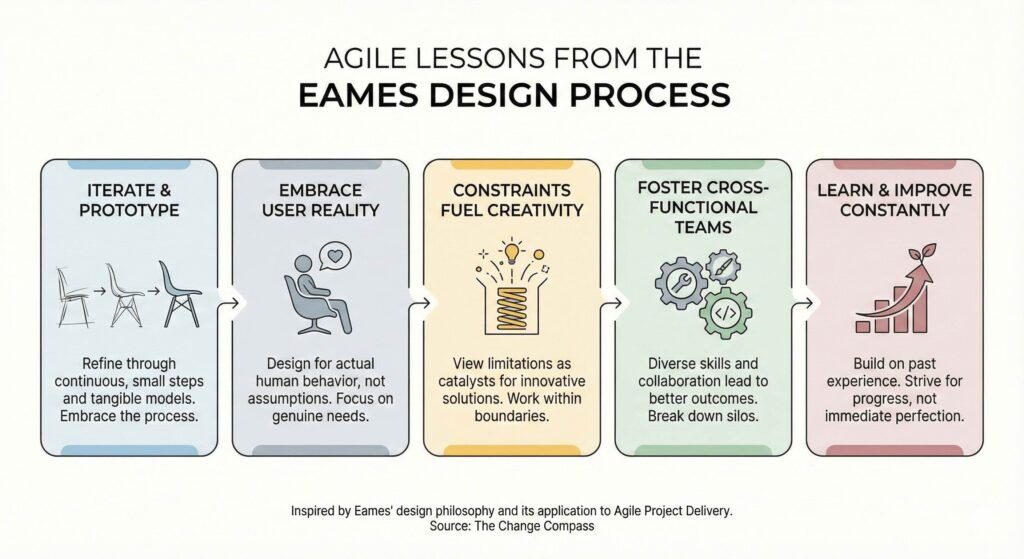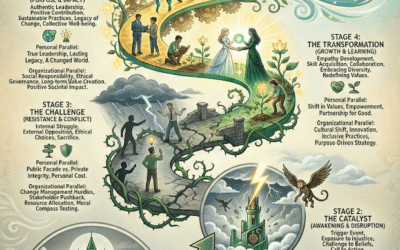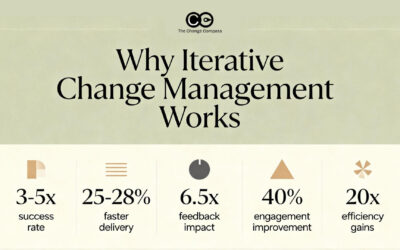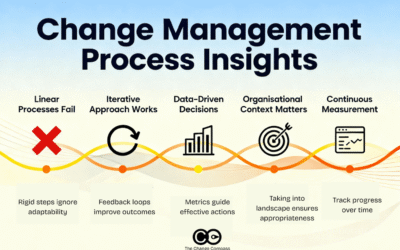Ray and Charles Eames, legendary mid-century designers, developed creative processes remarkably aligned with modern agile methodologies. Their approach emphasised iteration, resource respect, and systems thinking, offering valuable lessons for today’s project teams facing complex delivery challenges.
This guide explores five key Eames principles and their direct application to agile project delivery. Change practitioners and project leaders gain practical insights to enhance iteration, stakeholder engagement, and systemic success.
What Agile Principles Did Eames Champion?
The Eames duo’s design philosophy prefigured agile concepts by decades. Their methods focused on practical experimentation, collective wisdom, and holistic systems. These are core tenets of contemporary agile delivery.
These principles translate directly to project environments, improving outcomes across technology rollouts, process changes, and organisational transformations.
1. Not Reinventing the Wheel: Leverage Collective Experience
Eames avoided starting from scratch, instead building on proven materials and techniques. Agile teams benefit similarly by tapping organisational knowledge rather than isolated innovation.
Practical Applications in Agile Delivery
- Previous rollout lessons: Review past implementations of similar products or services to anticipate adoption challenges and success factors.
- Stakeholder group insights: Consult colleagues experienced with specific audience dynamics and communication preferences.
- Solution design patterns: Adapt approaches proven effective in prior technical or process solutions.
- Timeline strategies: Apply scheduling techniques refined through previous deadline pressures.
- Learning intervention successes: Reuse effective training content, delivery methods, and evaluation frameworks.
This principle prevents redundant effort while accelerating delivery through proven foundations.
2. Continuous Testing and Learning: Iterative Refinement
The Eames process featured constant prototyping and feedback, mirroring agile’s iterative cycles. Every team member, not just designers, contributes to this learning loop.
Change Management Testing Examples
- Message validation: A/B test communications with target audiences to measure resonance and engagement.
- Learning content trials: Pilot training modules with sample groups, gathering feedback on structure, clarity, and delivery medium.
- Impact assessment accuracy: Validate change impact analysis directly with end users rather than proxies alone.
Digital tools enable scalable testing, ensuring solutions evolve toward optimal fit-for-purpose outcomes.
3. Respecting the Materials at Hand: Understand Your Resources
Eames emphasised the importance of recognising the capabilities and limitations of available resources. In agile project delivery, this means deeply understanding people, systems, processes, and stakeholder capacities.
Applying Resource Respect in Agile Projects
- Assess team skills and system maturity before designing interventions.
- Adapt project plans based on stakeholder readiness and local constraints.
- Support change leads in gauging the ability levels of different groups to absorb new processes.
- Tailor communication and training to maximise relevance and effectiveness given resource realities.
This approach builds realistic, sustainable change strategies aligned with organisational strengths and challenges.

4. Generating New Perspectives and Ideas Through Play and Fun
The Eames valued play as a creative catalyst, fostering new ideas and fresh perspectives. Agile teams benefit from incorporating elements of play, fun, and experimentation into their work.
Practical Ways to Embed Play in Agile Delivery
- Run hackathons or innovation sprints encouraging out-of-the-box thinking.
- Design team-building activities that mix fun with purposeful reflection on project goals.
- Use gamification techniques to increase engagement in learning and adoption tasks.
- Foster a psychologically safe environment where experimentation and mistakes are accepted as learning opportunities.
Play enhances creativity, collaboration, and morale, supporting higher-quality outcomes.
5. Eventually Everything Connects: Embrace Systems Thinking
The Eames stressed seeing the broader picture and understanding how various elements interlink to form a larger system. This mindset is vital in agile delivery, where dependencies and impacts extend beyond single teams or projects.
Systems Thinking in Agile Projects
- Map connections among processes, systems, communications, training, and branding to ensure cohesive delivery.
- Identify how multiple change initiatives intersect and impact shared stakeholders or resources.
- Help stakeholders understand how different initiatives support broader organisational strategies.
- Use system maps and visualisations to support planning, risk assessment, and communication.
This holistic awareness prevents siloed work and promotes integrated, effective change.
Implementation Roadmap for Eames-Inspired Agile Delivery
Applying These Principles in Modern Projects
Quick-Start Actions for Teams
- Conduct knowledge audits to capture previous rollout experiences across the organisation.
- Schedule regular testing cycles for communications, training, and impact assessments.
- Map resource capabilities and limitations during project kickoff planning.
- Plan quarterly innovation sessions incorporating play and experimentation elements.
- Create visual system maps showing project interconnections and dependencies.
Building Organisational Support
- Train change leads in resource assessment and systems thinking techniques.
- Establish cross-project knowledge sharing forums.
- Integrate Eames principles into agile training and certification programs.
- Use success stories to demonstrate ROI from iterative testing and collective learning.
These steps embed timeless design wisdom into contemporary delivery practices.
Cultural Considerations for Success
Overcoming Common Barriers
Success requires psychological safety for experimentation and leadership support for non-traditional approaches. Traditional organisations may resist play-based innovation, requiring champions to demonstrate tangible benefits first.
Scaling Across Teams
Start with pilot projects showcasing measurable improvements in delivery speed, stakeholder satisfaction, and adoption rates. Use these case studies to expand practice organisation-wide.
Measuring Impact
Track metrics like iteration cycle time reduction, stakeholder engagement scores, knowledge reuse rates, and cross-project collaboration frequency to validate principle effectiveness.
Frequently Asked Questions (FAQ)
What makes Eames principles relevant to modern agile delivery?
Their focus on iteration, collective wisdom, resource respect, creativity through play, and systems thinking directly addresses contemporary project complexity and delivery challenges.
How do you implement continuous testing in change management?
Use A/B testing for messages, pilot training modules with user groups, and validate impact assessments directly with end users to refine approaches iteratively.
Why is systems thinking essential in agile projects?
Modern initiatives rarely operate in isolation. Understanding interconnections prevents siloed work and ensures cohesive delivery across multiple changes.
How can teams incorporate play into serious projects?
Run hackathons, gamify learning tasks, and design team activities blending fun with purposeful project reflection to boost creativity and morale.
What is the first step in applying ‘not reinventing the wheel’?
Conduct knowledge audits capturing previous rollout lessons, stakeholder insights, and proven solution patterns across the organisation.
Read our ultimate guide to agile for change manager.
—————–






